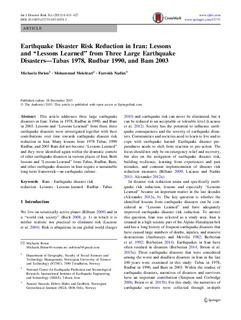| dc.contributor.author | Ibrion, Mihaela | |
| dc.contributor.author | Mokhtari, Mohammad | |
| dc.contributor.author | Nadim, Farrokh | |
| dc.date.accessioned | 2016-04-07T09:28:29Z | |
| dc.date.accessioned | 2016-04-21T11:35:49Z | |
| dc.date.available | 2016-04-07T09:28:29Z | |
| dc.date.available | 2016-04-21T11:35:49Z | |
| dc.date.issued | 2015 | |
| dc.identifier.citation | International Journal of Disaster Risk Science 2015, 6(4):415-427 | nb_NO |
| dc.identifier.issn | 2095-0055 | |
| dc.identifier.uri | http://hdl.handle.net/11250/2386757 | |
| dc.description.abstract | This article addresses three large earthquake disasters in Iran: Tabas in 1978, Rudbar in 1990, and Bam in 2003. Lessons and "Lessons Learned" from these three earthquake disasters were investigated together with their contributions over time towards earthquake disaster risk reduction in Iran. Many lessons from 1978 Tabas, 1990 Rudbar, and 2003 Bam did not become "Lessons Learned" and they were identified again within the dramatic context of other earthquake disasters in various places of Iran. Both lessons and "Lessons Learned" from Tabas, Rudbar, Bam, and other earthquake disasters in Iran require a sustainable long-term framework-an earthquake culture. | nb_NO |
| dc.language.iso | eng | nb_NO |
| dc.publisher | SpringerOpen | nb_NO |
| dc.rights | Navngivelse 3.0 Norge | * |
| dc.rights.uri | http://creativecommons.org/licenses/by/3.0/no/ | * |
| dc.title | Earthquake Disaster Risk Reduction in Iran: Lessons and ‘‘Lessons Learned’’ from Three Large EarthquakeDisasters—Tabas 1978, Rudbar 1990, and Bam 2003 | nb_NO |
| dc.type | Journal article | nb_NO |
| dc.type | Peer reviewed | nb_NO |
| dc.date.updated | 2016-04-07T09:28:29Z | |
| dc.source.pagenumber | 415-427 | nb_NO |
| dc.source.volume | 6 | nb_NO |
| dc.source.journal | International Journal of Disaster Risk Science | nb_NO |
| dc.source.issue | 4 | nb_NO |
| dc.identifier.doi | 10.1007/s13753-015-0074-1 | |
| dc.identifier.cristin | 1319375 | |
| dc.description.localcode | This article is distributed under the terms of the Creative Commons Attribution 4.0 International License (http://creativecommons.org/licenses/by/4.0/), which permits unrestricted use, distribution, and reproduction in any medium, provided you give appropriate credit to the original author(s) and the source, provide a link to the Creative Commons license, and indicate if changes were made | nb_NO |

